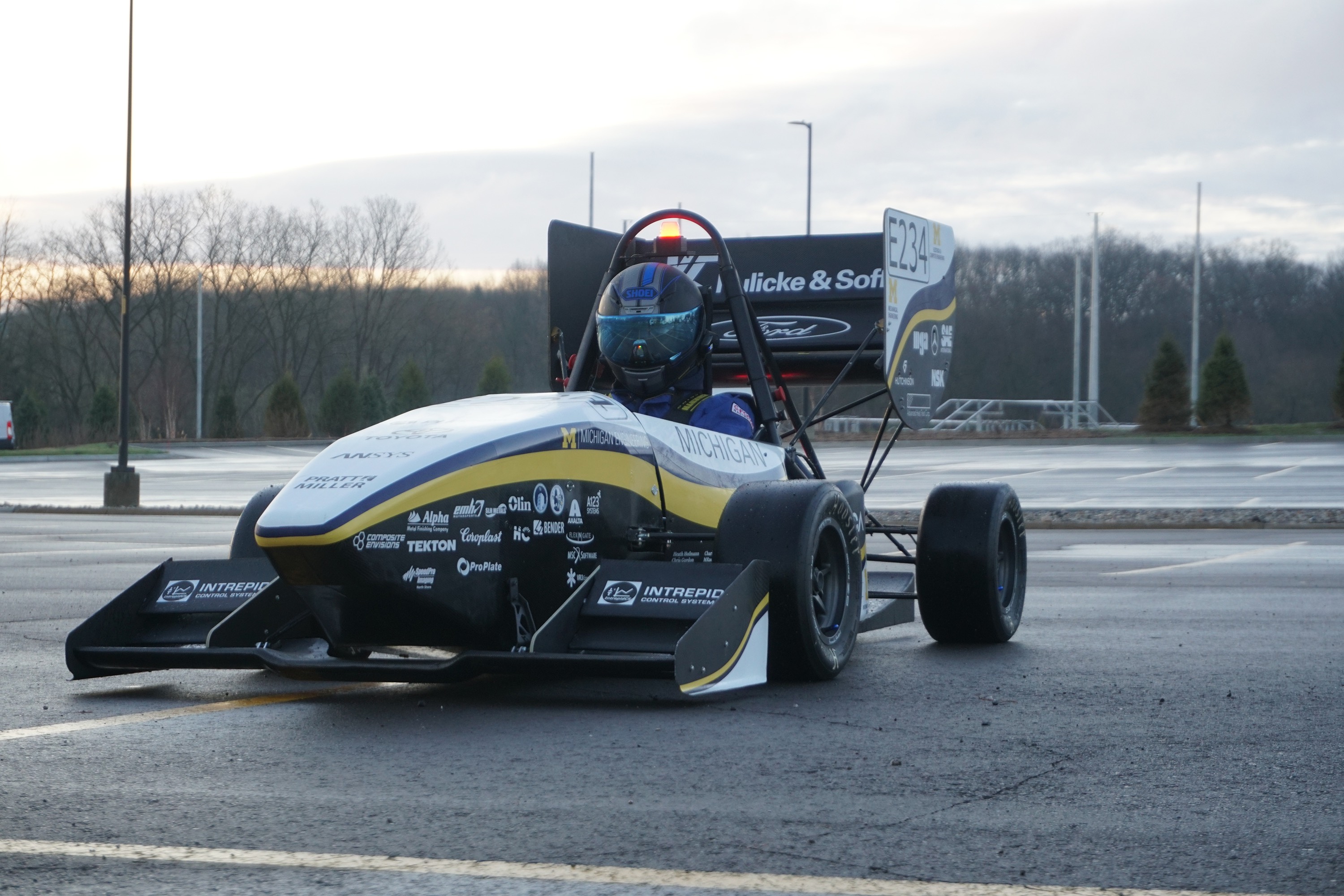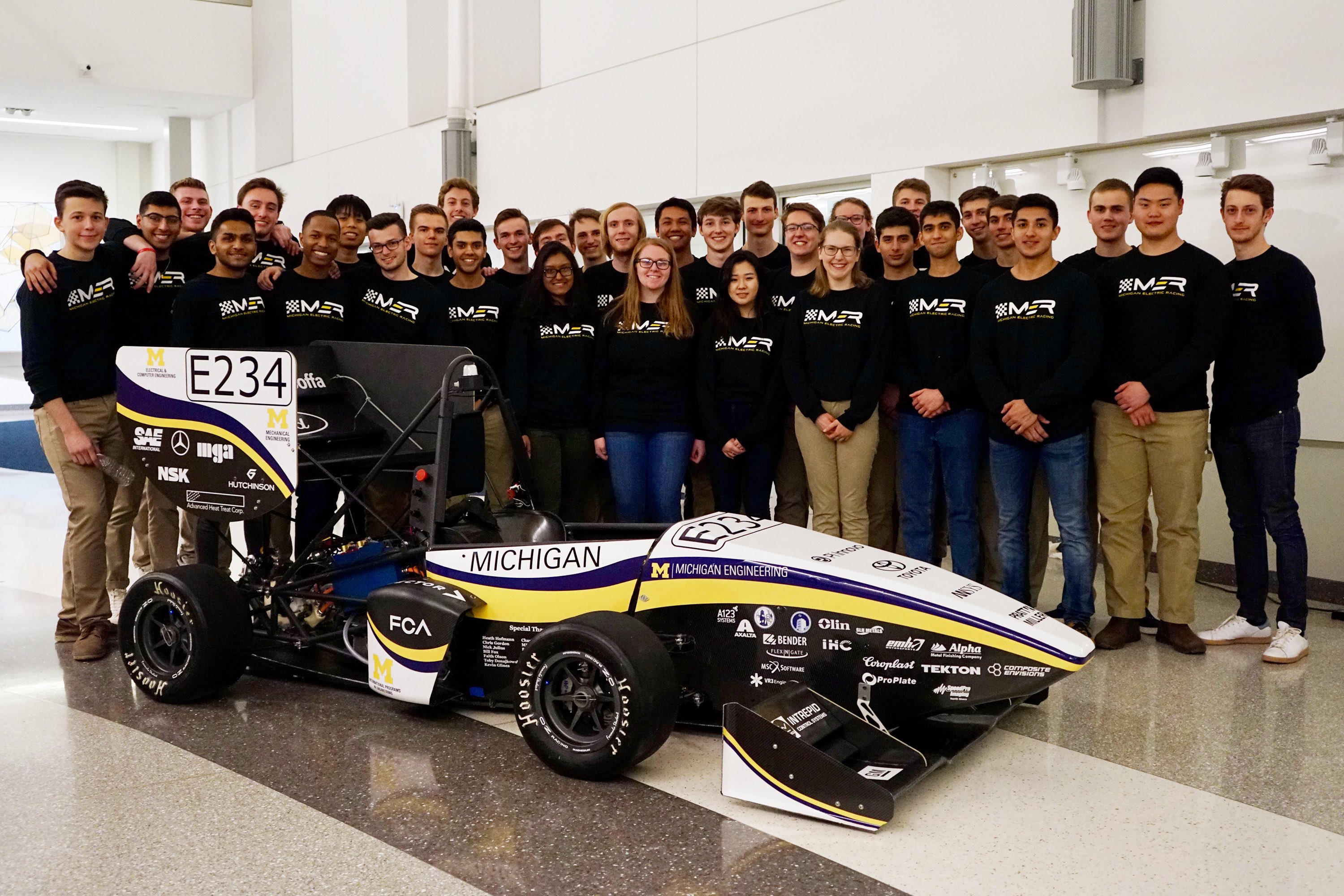Michigan Electric Racing Revs Up
This summer, Michigan Electric Racing will race their first all-electric car in Formula-style competitions they plan to win.

 Enlarge
Enlarge
For years, the Michigan Hybrid Racing (MHybrid) team tested their ingenuity, engineering know-how, and pure adrenaline drive as U-M’s official Formula Hybrid racing team. Now, they will push the racing game forward even further by competing with their first ever all-electric vehicle.
MHybrid– a multidisciplinary, student-run organization – was founded in 2011 with the mission to design, build, test, and finance their own high-performance, hybrid-electric Formula-style race car. This year, they have rebranded as Michigan Electric Racing (MER) and will compete against teams from all over the world at Formula Electric in Lincoln, Nebraska, and Formula North in Barrie, Ontario, Canada. In addition to the challenges of building and racing a brand new style of vehicle, the students will also have to adapt to a different kind of race that features rules and requirements specific to electric vehicles.
“I feel that Racing spans the difference between academics and sports perfectly,” said Ethan Novilla, a junior in Electrical Engineering and member of the Controls division, which is responsible for all low voltage wiring and vehicle software. “On one hand, it takes an extremely knowledgeable team of people to create, manage, and maintain a race car. On the other, it’s insanely competitive and skill driven.”
The team decided to transition from hybrid vehicles to full-electric as a response to overall trends in the automotive industry. Many carmakers are turning to electric vehicles to help them address consumer demands, such as a need for better fuel efficiency and cars that have less environmental impact.

 Enlarge
Enlarge
Hybrid vehicles were the first step toward engineering sustainable transportation, but while they pollute less than traditional internal combustion engines, they still rely on gasoline and generate tailpipe emissions. Electric vehicles, however, produce no emissions, including pollutants that cause smog. This improves air quality, which provides great benefits to human health. Moreover, electric vehicles theoretically won’t require the use of fossil fuels, as they could be charged with energy generated by renewable sources, such as solar or wind power. In addition to the environmental benefits, reducing the country’s reliance on fossil fuels makes us more resilient to fluctuations in fossil fuel price and supply.
What’s more, electric motors are very responsive and provide good torque. Charging electric vehicles is often a lot cheaper than filling up a gas tank, and as the number of charging stations increase, people will have more options to charge their cars at work or at home, which means less time spent driving around looking for a gas station.
But despite the benefits, the transition to electric vehicles has been slow considering they’ve been around since the mid-19th century.
“The infrastructure wasn’t really there for electric vehicles,” said ECE Prof. Heath Hofmann, who specializes in power electronics and electromechanical systems and serves as faculty advisor to the team. “The technology wasn’t there. There weren’t charging stations; there weren’t batteries with the energy storage capabilities that there are now.”
But all that has changed, and MER plans to showcase just what a U-M electric car can do.
“Our biggest goal is to win competitions,” said Grace Stridick, a junior in Mechanical Engineering and co-captain of the team. “We want to prove to the nation and to the world that we’re a strong electric racing team.”
We're training some of the best engineers at the University of Michigan because of the hands-on experience alone.
Grace Stridick, MER Co-Captain
When designing a sustainable vehicle, it’s common to want to design one that has the best gas mileage or runs entirely off of a type of renewable energy. It seems strange that an additional criterion would be that it is good at racing. However, Hofmann references Tesla to argue that, no matter how sustainable your car is, consumers ultimately want a cool car.
“By emphasizing the performance of their vehicles, Tesla has opened their market beyond the people who want their products only for sustainability reasons,” Hofmann – who worked with Tesla when they were designing their first vehicle, the Roadster – said. “I thought that was pretty clever and, at least thus far, a successful strategy for them.”
For this reason, members of MER are exposed not only to the engineering challenges of designing an all-electric racing car, but they are also coping with the real-world economic and market challenges.
“We’re training some of the best engineers at the University of Michigan because of the hands-on experience alone,” Stridick said. “You can learn all you want in class, but until you actually implement it, you don’t have a deep understanding.”
MER is open to students from across the university, including non-engineering students. The students do all the vehicle design work, coordinate all the manufacturing, and manage the entire budget.

 Enlarge
Enlarge
“It’s also a multidisciplinary design project, which is awesome,” said Michael Reber, a junior in Computer Engineering and a member of the Electric Vehicle Powertrain division, which is responsible for the power delivery to the motors and most of the safety systems. “You work with and depend on engineers from all disciplines, which forces you to consider the full scope of your engineering decisions.”
The holistic nature of the project is part of what attracted Jacob Kromm – a junior in Electrical Engineering and leader of the Electric Vehicle Powertrain division – to the team.
“This team seemed to have the largest growth opportunity and the largest opportunity to make a difference in my time at the university,” Kromm said. “This project is something I would try and do on my own anyways, so it’s very exciting to have the resources and the teammates to work with.”
However, in the end, everyone agrees that the best part of the team is getting to drive the car – something Hofmann has yet to experience.
“Usually, the students are so busy working and testing before the competitions that they need all the time they can get,” Hofmann said. “So, me taking the car for joy rides is usually frowned upon.”
Perhaps this will finally be his year.
For more information on MER, including how to get involved, visit their website.
 MENU
MENU 
